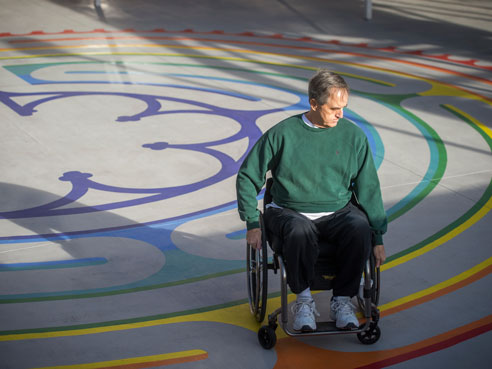The University of Alabama at Birmingham Hospital has created a labyrinth to promote wellness and healing for patients, families and staff. A labyrinth is an intricate pattern or path depicted on a floor which can be walked or transversed in a wheelchair. The UAB labyrinth is painted on the floor of the Holmes Pavilion, an outdoor space adjacent to the Spain Rehabilitation Center.
Labyrinths are an ancient symbol. An individual follows the winding pathway to the center of the labyrinth and then back out again, a process that has been referred to as walking meditation.
“It is a concept that has been gaining in popularity in health care settings,” said Cathy Newhouse, director of Rehabilitation Services at UAB Hospital and one of the team responsible for the UAB labyrinth. “A labyrinth helps a person focus spiritually and emotionally. Research has shown that walking a labyrinth can promote healing and enhance wellness.”
The UAB labyrinth is 32 feet by 32 feet, and follows a traditional design. It is painted in the colors of the Chakra, energy points in the body derived from Hindu spiritual tradition.
 Mark McColl, a patient at UAB's Spain Rehab, explores the labyrinth as part of his therapy. McColl said it was emotionally and physically rewarding.Melissa Turnage, the dance artist-in-residence for UAB’s Institute for Arts in Medicine, helped drive the labyrinth project. She first became interested in the concept while working with cardiac patients.
Mark McColl, a patient at UAB's Spain Rehab, explores the labyrinth as part of his therapy. McColl said it was emotionally and physically rewarding.Melissa Turnage, the dance artist-in-residence for UAB’s Institute for Arts in Medicine, helped drive the labyrinth project. She first became interested in the concept while working with cardiac patients.
“I was trying to bring elements of dance and movement to their care, but many were limited in what they could do physically,” Turnage said. “I brought a finger labyrinth — a small design printed on a piece of paper — that they could trace with their finger. It had such an effect that I began thinking that a larger, walkable labyrinth might be very worthwhile.”
Diane Wood, a chaplain in UAB’s Center for Palliative and Supportive Care, has also been a leader in the labyrinth project. She too has seen the benefit of finger labyrinths and often employs a portable labyrinth painted on a piece of canvas.
“We’ve set the canvas labyrinth up twice at UAB over the past several months and saw wonderful response,” Wood said. “That helped solidify the idea of making a permanent labyrinth, accessible to all, as a gift to our patients, families and staff in the hope it will be a useful tool for meditation and prayer. Walking the labyrinth can be a means of centering, healing, grieving, calming, decision-making or celebration.”
In the weeks prior to the labyrinth’s creation, patients and staff were encouraged to write messages on the concrete floor where the labyrinth would eventually be painted. Those messages — messages of hope and affirmation — are now sealed beneath the labyrinth. Printed materials will be available describing the concept and providing tips on how to prepare in order to achieve the most meaningful experience. There will also be a mechanism for leaving messages, memories or remembrances.
“It will be available to anyone at any time,” Newhouse said. “People can use the labyrinth to take a moment to pause and reflect as they are rushing back and forth during their day, heading home after a bad day, or gearing up to face a new one.”
Newhouse says the labyrinth can be especially valuable for patients at the Spain Center undergoing rehabilitation from spinal cord injury, brain trauma or other serious injury.
“Many of our rehab patients are dealing with a life-changing experience and coming to grips with how their lives may be different,” she said. “The labyrinth can be a catalyst, a transition, as they come to an understanding of the reality of their new life. It’s a way for patients and families to come to a level of acceptance.”
Turnage says the labyrinth is a part of the overall healing environment at UAB.
“Many people find that walking helps clear the mind when faced by problems or concerns,” she said. “A labyrinth provides focus and direction. Something happens when you walk a labyrinth. Things look and feel a little different when you are done.”
The labyrinth, in the Holmes Pavilion, is adjacent to the second-floor walkway at the Spain Rehabilitation Center. Drexel Rayford, Patti Keeler and Ginger Millet in Pastoral Care were also integral to the project.
